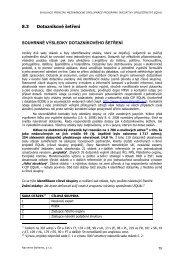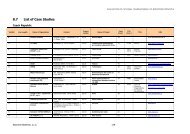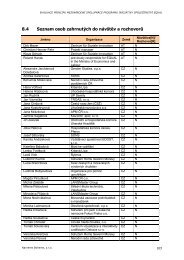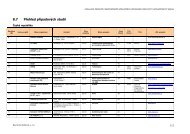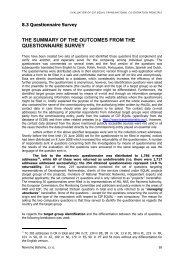EQUAL - Final report - eng - navreme
EQUAL - Final report - eng - navreme
EQUAL - Final report - eng - navreme
You also want an ePaper? Increase the reach of your titles
YUMPU automatically turns print PDFs into web optimized ePapers that Google loves.
EVALUATION OF CIP <strong>EQUAL</strong> TRANSNATIONAL CO-OPERATION PRINCIPLE<br />
CIP <strong>EQUAL</strong> Managing Authority in selected EU countries MA EU<br />
Applicants 4 APP<br />
3.4 Evaluation methodology<br />
For the findings necessary to formulate conclusions and recommendations, such research and<br />
evaluation methods were used so that the selected method would be able to find sources for the<br />
answers to the given evaluation questions most effectively. The methods, the detailed description of<br />
which we mention below, were aimed at the following target groups:<br />
RESEARCH / EVALUATION<br />
METHOD<br />
ACRONYM<br />
OF THE<br />
METHOD<br />
TARGET GROUP<br />
Analysis of documents ANAL No target group<br />
Questionnaire QUE All target groups<br />
Evaluation visit VIS DP, DP EU, CLIENT<br />
Evaluation of processes PROC NSS, NSS EU, MA, MA EU<br />
Focus group FG MA, NSS<br />
Continual (ongoing) evaluation CONT Evaluation team<br />
Case study CASE DP, DP EU<br />
Structured interview INT EC, POLIT, NSS, NSS EU, EXP<br />
SWOT SWOT No target group<br />
Each of the mentioned methods is characterised in details below. It is also described at each method, in<br />
which way the respondents were chosen, however, it is valid in general that they were selected<br />
according to the representativeness rule by means of quota selection.<br />
3.4.1 Analysis of documents<br />
A supporting method is concerned, the results of which served for the preparation of other evaluation<br />
methods, as a direct input of the process evaluation. It played a role of a key method in fulfilment of<br />
the tasks connected with topics 1 and 6. “Research from a table” is concerned (contrary to the field<br />
methods). The list of the documents analysed is mentioned in Annex 8.9 and the findings from the<br />
analysis of documents are mentioned then in special chapters.<br />
3.4.2 Questionnaires<br />
Two sets of questions came into existence and the questions were identified, which complement each<br />
other, verify each other mutually, and above all serve for comparison between the individual groups.<br />
The comments to the questionnaire had been made several times; the resulting form of the questions<br />
was then translated from English into Czech, Polish, French, Portuguese, Italian, Spanish and Dutch.<br />
The questionnaires were distributed in the electronic form only, namely through a web application,<br />
which enables safe and comfortable completion of the form and its anonymous sending on-line. The<br />
data are stored directly into a database, which increases the efficiency of their further processing<br />
significantly. The questionnaire was anonymous, but in order to be able to distinguish the target<br />
groups addressed by the questionnaire, two identification questions were mentioned in the<br />
introductory part of the questionnaire (country of origin and the type of the target group). The<br />
established target groups were addressed by means of an e-mail and an information campaign with<br />
accompanying information, which contained the www address, on which the questionnaire can be<br />
completed, explained briefly the meaning of the questionnaire and of the whole evaluation, further it<br />
contained the name of the contracting authority, an authorizing letter from MoLSA and the contact<br />
data for case of inquiries. Letters in the above-mentioned languages were sent to the contacts<br />
4 This group is a secondary one, it is not mentioned at the majority of activities in the tables to the individual<br />
topics and tasks as a target group, it was addressed by means of a questionnaire and above all, some<br />
recommendations for future management of the aid from the ESF are aimed at it.<br />
Navreme Boheme, s.r.o. 23



